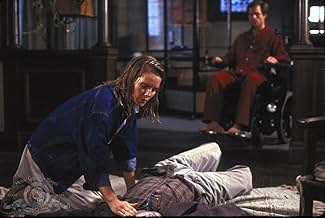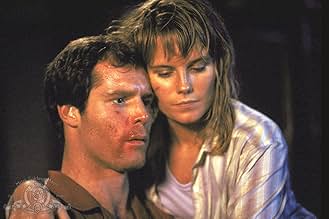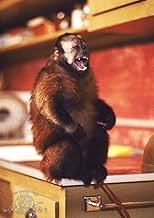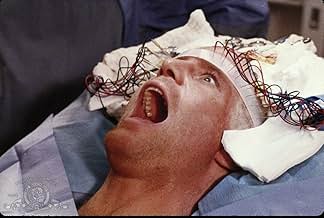NOTE IMDb
6,2/10
14 k
MA NOTE
Un paraplégique est assisté par un petit singe dressé, jusqu'à ce que ce dernier commence à développer des sentiments, et de la colère, à l'encontre de son nouveau maître.Un paraplégique est assisté par un petit singe dressé, jusqu'à ce que ce dernier commence à développer des sentiments, et de la colère, à l'encontre de son nouveau maître.Un paraplégique est assisté par un petit singe dressé, jusqu'à ce que ce dernier commence à développer des sentiments, et de la colère, à l'encontre de son nouveau maître.
- Réalisation
- Scénario
- Casting principal
- Récompenses
- 7 victoires et 2 nominations au total
Avis à la une
While this will likely never be considered one of filmmaker George Romero's best, it still represents a commendable effort in one of his rare forays into studio productions (in this case Orion). Scripted by Romero based on a novel by Michael Stewart, it tells the story of Allan Mann (handsome Jason Beghe), a law student who gets into a horrible accident that renders him a quadriplegic. He soon becomes despondent enough to attempt suicide, but soon he receives some temporary salvation in the form of Ella (Boo), a capuchin monkey who is trained to see to his needs. What he doesn't know is that his friend Geoffrey (John Pankow) has been playing mad scientist and injecting the cute lil' thing with human brain cells. Soon the bond between patient and helper becomes so strong that a mental connection is made, and Ella is physically acting out Allan's worst impulses. So what is he going to do about this little homicidal primate? Romero does a good job here at telling a fairly interesting story, although some viewers might be turned off at the lack of sympathetic characters. Most of them are flawed to some degree or another - creepy dean Burbage (Stephen Root), smarmy, incompetent doctor Wiseman (Stanley Tucci), fair-weather girlfriend Linda (Janine Turner), bitchy nurse Maryanne (Christine Forrest, a.k.a. Mrs. Romero) - and even a guy like Geoffrey, who initially just wants to help, has his problems as he's obsessed with his work. At least Allan has an appealing love interest played by Kate McNeil, whom horror fans will recognize as the lead in the slasher "The House on Sorority Row". The cast is pretty good overall; Joyce Van Patten plays the stereotypically smothering mother to good effect, and it's a treat to see character actors Root and Tucci near the beginnings of their careers, but the one performer the audience is likely to remember is Boo, who's adorable and very well trained; the animal action is first rate throughout (there's also a rather annoying bird on hand). The evolving relationship between Allan and Ella makes for a compelling hook, and it makes one appreciate the real-life efforts that people put into training service animals, and the animals themselves. The film is light on horror - most of the violence is implied - as Romero tends to go for a more psychological approach, and refrains from going for the gore. Overall, this is a decent flick, worth a look for genre fans who are interested in checking out Romero's non-zombie films. Seven out of 10.
Aah, George A Romero - the master himself - does it again. This is a very stylish thriller and perfect study of how man's apparent progress goes horribly wrong.
The film captured my attention from the opening moment. Jason Beghe is perfectly cast in this demanding role. It was interesting (if somewhat creepy) to see how things started going wrong, very subtle at first, and how the situation declined to absolute chaos and mayhem. The romance interest felt very natural and enjoyable. Quite often the romance feels forced into a film; here it seemed inevitable given the circumstances.
This is a true classic!
The film captured my attention from the opening moment. Jason Beghe is perfectly cast in this demanding role. It was interesting (if somewhat creepy) to see how things started going wrong, very subtle at first, and how the situation declined to absolute chaos and mayhem. The romance interest felt very natural and enjoyable. Quite often the romance feels forced into a film; here it seemed inevitable given the circumstances.
This is a true classic!
George Romero does an excellent job of swapping Zombies for Monkeys. This film may sound ridiculous in the most preposterous way. But then again, we now live in a world of Snakes on a Plane and Burning Bright, so this is a little easier to swallow. In its genre, it is one of the best examples, and I'm not just talking about killer animals. I'm also referring to the stalker/obsessive partner/friend genre.
What Romero does brilliantly, is to take a number of characters and the audience on a journey of emotions and self discovery. For example, I started off wanting one of these monkeys. The relationship built up is a genuinely loving one. It's really cute, and this could easily be one of those lifetime inspirational movies. If the monkey wasn't a genetically modified, telepathic, homicidal, psycho monkey. The well trained monkey takes us from tragic victim of experiments, to a loving carer. We get a wonderful cleaning montage, as the monkey helps the friendship expands. The monkey's obsession grows steadily. It starts off with a few temper tantrums and escalates into bananas in the slippers. Soon bananas turn to murder. It's the evolution of all species.
None of this would work if it wasn't for a dramatic human connection. Beghe is a law student/athlete that is paralysed. He goes through acceptance, denial, frustration, which is understandable as his girlfriend leaves him for his doctor (a sleazy Tucci), he gets a patronizing nurse, and then his overbearing mother. It's great to see how the characters react to Beghe's quadriplegia, as it enforces Beghe's later anger. Beghe also does a terrific job of facial acting, which is most important as he can't use his body. In a single look he can convey the embarrassment of his mother having to wash him.
On the surface, this is a story of a monkey being a bitch to a cripple. But look deep down, REAAAAAAALLY deep, and you'll see a social commentary. For a long time, the monkey is the only one that treats Beghe as an equal. It doesn't throw money at his problem, try and cheer him up, nor can the monkey do everything for him.
Romero fills the film with dread, absurdity, and most of all a serious edge that clearly does the film justice. It's easy to mock this film. But the truth is, this could actually happen. Monkeys are creepy and untrustworthy.
What Romero does brilliantly, is to take a number of characters and the audience on a journey of emotions and self discovery. For example, I started off wanting one of these monkeys. The relationship built up is a genuinely loving one. It's really cute, and this could easily be one of those lifetime inspirational movies. If the monkey wasn't a genetically modified, telepathic, homicidal, psycho monkey. The well trained monkey takes us from tragic victim of experiments, to a loving carer. We get a wonderful cleaning montage, as the monkey helps the friendship expands. The monkey's obsession grows steadily. It starts off with a few temper tantrums and escalates into bananas in the slippers. Soon bananas turn to murder. It's the evolution of all species.
None of this would work if it wasn't for a dramatic human connection. Beghe is a law student/athlete that is paralysed. He goes through acceptance, denial, frustration, which is understandable as his girlfriend leaves him for his doctor (a sleazy Tucci), he gets a patronizing nurse, and then his overbearing mother. It's great to see how the characters react to Beghe's quadriplegia, as it enforces Beghe's later anger. Beghe also does a terrific job of facial acting, which is most important as he can't use his body. In a single look he can convey the embarrassment of his mother having to wash him.
On the surface, this is a story of a monkey being a bitch to a cripple. But look deep down, REAAAAAAALLY deep, and you'll see a social commentary. For a long time, the monkey is the only one that treats Beghe as an equal. It doesn't throw money at his problem, try and cheer him up, nor can the monkey do everything for him.
Romero fills the film with dread, absurdity, and most of all a serious edge that clearly does the film justice. It's easy to mock this film. But the truth is, this could actually happen. Monkeys are creepy and untrustworthy.
It seems that every once and a while, a neat little horror film comes along that eschews genre conventions and is able to tap into a new vein to provide its scares. Writer-director George A. Romero, of "Night of the Living Dead" (1968) and "Dawn of the Dead" (1978) infamy, brings forth "Monkey Shines," an adaptation of the novel by Michael Stewart.
Romero has always been a director who goes for the throat in delivering the shocks in his horror pictures. But in the savage gore and mayhem, he has never lost sight of the human characters, their drama, and their plight. In "Monkey Shines," Romero seems to have been domesticated somewhat - dare I say, "tamed" - in that characters and drama are most essential to the core of the film, and that horror is really the last thing on his mind.
"Monkey Shines" begins with the Good Day Gone Bad, Really Bad: Allan Mann (Jason Beghe), is a highly physical law student who goes for a jog early one morning after spending the night with his girlfriend Linda (Janine Turner). To avoid a dog on the sidewalk, he unknowingly runs into the path of an oncoming truck. He wakes up several weeks later in the hospital, now a quadriplegic, paralyzed, unable to use his body anywhere below the neck.
Confined to a wheelchair he moves around by working a lever with his mouth and having to rely on live-in nurse Maryanne (Christine Forrest), his doting, overbearing mother Dorothy (Joyce Van Patten) and having to deal with his pompous surgeon Dr. Wiseman (Stanley Tucci) who begins having an affair with Linda, Allan gives up and tries to commit suicide. Luckily, Allan's mad-scientist friend Geoffrey (John Pankow) may have a solution: Ella, an extremely intelligent capuchin monkey who is being trained by animal specialist Melanie Parker (Kate McNiel) to be a sort of help-primate for paraplegics and quadriplegics, much like a seeing-eye dog is used for blind people.
At first, a great weight seems lifted off Allan's shoulders; Ella's the perfect helper - she can answer the phone, play cassette tapes in the radio, and even help Allan turn the pages of his books when he reads. She even raises her hand in class for her turn to be called on. A deep bond develops between the two that's right out of any made-for-TV movie about hope and determination to beat the odds. Of course, and this is where the horror elements begin to kick in, what Allan doesn't know is that Ella is really Geoffrey's guinea pig in an experiment to create super-intelligent primates: he's been secretly injecting her with human brain tissue, which explains her super-intelligence in helping to make Allan's life a little bit easier. Even more horrifically, Allan has been having incredibly realistic nightmares in which he has acquired a monkey's-eye view of the world, and Ella is subconsciously acting out his deeply-suppressed anger, frustration, hatred, and rage for those around him. And it soon begins a battle of wits to see who is really controlling who, which also sees if Charles Darwin was really right all those years ago.
"Monkey Shines" develops so nicely during its first hour that it's easy to forget that first and foremost, it's a horror film and not just any horror film, a George A. Romero-directed horror film. Romero shows remarkable restraint in combining both the human story with the horror story, that both elements are given enough screen time to thoroughly develop and not seem so tacked-on to each other. That atmosphere and tension of the film's horror-themed second half is pretty intense, even if things can be forgiven for the haunted house-style climax.
This is easily the best-acted film Romero has ever directed, though obviously it's not his best; that honor goes to "Dawn of the Dead." All of the characters turn in fine and realistic performances, including John Pankow as Allan's drug-addled mad-scientist friend who truly has his friend's best interests at heart, even if they're morally gray in the end. But there is one performer who is highly deserving of much praise, and that is Jason Beghe. Jason Beghe delivers a strong, controlled central performance that in my opinion, was criminally overlooked by a great many awards organizations. His performance is one of the most convincing and sympathetic portrayals of a physically handicapped protagonist I've ever seen in the movies. Essentially a prisoner in his own body, he hits every emotive note perfectly, and we believe and can see where and why his anger and rage at his condition is one of the most believable performances in the history of Romero's long and distinguished career as a filmmaker.
"Monkey Shines" is an overlooked career highlight from a highly distinguished director, George A. Romero. Even more so, Jason Beghe's criminally underrated performance makes the film even more worthy of more significant praise.
This is one horror film that isn't monkeying around in the end. It is really scary.
8/10
Romero has always been a director who goes for the throat in delivering the shocks in his horror pictures. But in the savage gore and mayhem, he has never lost sight of the human characters, their drama, and their plight. In "Monkey Shines," Romero seems to have been domesticated somewhat - dare I say, "tamed" - in that characters and drama are most essential to the core of the film, and that horror is really the last thing on his mind.
"Monkey Shines" begins with the Good Day Gone Bad, Really Bad: Allan Mann (Jason Beghe), is a highly physical law student who goes for a jog early one morning after spending the night with his girlfriend Linda (Janine Turner). To avoid a dog on the sidewalk, he unknowingly runs into the path of an oncoming truck. He wakes up several weeks later in the hospital, now a quadriplegic, paralyzed, unable to use his body anywhere below the neck.
Confined to a wheelchair he moves around by working a lever with his mouth and having to rely on live-in nurse Maryanne (Christine Forrest), his doting, overbearing mother Dorothy (Joyce Van Patten) and having to deal with his pompous surgeon Dr. Wiseman (Stanley Tucci) who begins having an affair with Linda, Allan gives up and tries to commit suicide. Luckily, Allan's mad-scientist friend Geoffrey (John Pankow) may have a solution: Ella, an extremely intelligent capuchin monkey who is being trained by animal specialist Melanie Parker (Kate McNiel) to be a sort of help-primate for paraplegics and quadriplegics, much like a seeing-eye dog is used for blind people.
At first, a great weight seems lifted off Allan's shoulders; Ella's the perfect helper - she can answer the phone, play cassette tapes in the radio, and even help Allan turn the pages of his books when he reads. She even raises her hand in class for her turn to be called on. A deep bond develops between the two that's right out of any made-for-TV movie about hope and determination to beat the odds. Of course, and this is where the horror elements begin to kick in, what Allan doesn't know is that Ella is really Geoffrey's guinea pig in an experiment to create super-intelligent primates: he's been secretly injecting her with human brain tissue, which explains her super-intelligence in helping to make Allan's life a little bit easier. Even more horrifically, Allan has been having incredibly realistic nightmares in which he has acquired a monkey's-eye view of the world, and Ella is subconsciously acting out his deeply-suppressed anger, frustration, hatred, and rage for those around him. And it soon begins a battle of wits to see who is really controlling who, which also sees if Charles Darwin was really right all those years ago.
"Monkey Shines" develops so nicely during its first hour that it's easy to forget that first and foremost, it's a horror film and not just any horror film, a George A. Romero-directed horror film. Romero shows remarkable restraint in combining both the human story with the horror story, that both elements are given enough screen time to thoroughly develop and not seem so tacked-on to each other. That atmosphere and tension of the film's horror-themed second half is pretty intense, even if things can be forgiven for the haunted house-style climax.
This is easily the best-acted film Romero has ever directed, though obviously it's not his best; that honor goes to "Dawn of the Dead." All of the characters turn in fine and realistic performances, including John Pankow as Allan's drug-addled mad-scientist friend who truly has his friend's best interests at heart, even if they're morally gray in the end. But there is one performer who is highly deserving of much praise, and that is Jason Beghe. Jason Beghe delivers a strong, controlled central performance that in my opinion, was criminally overlooked by a great many awards organizations. His performance is one of the most convincing and sympathetic portrayals of a physically handicapped protagonist I've ever seen in the movies. Essentially a prisoner in his own body, he hits every emotive note perfectly, and we believe and can see where and why his anger and rage at his condition is one of the most believable performances in the history of Romero's long and distinguished career as a filmmaker.
"Monkey Shines" is an overlooked career highlight from a highly distinguished director, George A. Romero. Even more so, Jason Beghe's criminally underrated performance makes the film even more worthy of more significant praise.
This is one horror film that isn't monkeying around in the end. It is really scary.
8/10
This film has been described as a "horror film for people who don't like horror films." That's an apt description for this underrated psychological/supernatural thriller from Pittsburgh's master horror director, George A. Romero. To date, this is Romero's only studio film, and he had to make numerous compromises to the finished product. (The originally intended ending would have been a killer.) That said, the film still comes off as smart and sharp, with some very good casting. (John Pankow, recognizable from "Mad About You," is really excellent here, and there are nice early performances from Stephen Root, Stanley Tucci, and Janine Turner.) And check out the amazingly good editing in the last 10 minutes. Overall, while this is not first-tier Romero, it's a terrific little horror film.
Le saviez-vous
- AnecdotesThis was the first film role for Stephen Root, then a stage actor. According to Root, he had been instructed by his agent not to let the casting directors know that he was inexperienced with film as an actor. Root's official debut was Crocodile Dundee II (1988), which had been released in theaters a month before this film, despite being shot a month after it.
- GaffesFisher incorrectly refers to performing an "autopsy" on Ella. An autopsy is performed on human remains. The correct term for examining animal remains postmortem is "necropsy". This is a common mistake for most people, one that Fisher would not make, given his profession.
- Citations
Geoffrey Fisher: You're a clinical cunt.
- Crédits fous"Introducing Boo as Ella"
- Versions alternativesEarlier versions of Monkey Shines allegedly contained a bizarre brain surgery scene, as well as several abusive scenes involving the small monkey, Ellie. Although the scenes were all staged and no animals were harmed in the making of the movie, the filmmakers decided it would be better to simply leave them out to avoid conflicts.
- ConnexionsFeatured in Document of the Dead (1980)
Meilleurs choix
Connectez-vous pour évaluer et suivre la liste de favoris afin de recevoir des recommandations personnalisées
Détails
- Date de sortie
- Pays d’origine
- Langue
- Aussi connu sous le nom de
- Atracción diabólica
- Lieux de tournage
- Société de production
- Voir plus de crédits d'entreprise sur IMDbPro
Box-office
- Budget
- 7 000 000 $US (estimé)
- Montant brut aux États-Unis et au Canada
- 5 344 577 $US
- Week-end de sortie aux États-Unis et au Canada
- 1 902 024 $US
- 31 juil. 1988
- Montant brut mondial
- 5 344 577 $US
Contribuer à cette page
Suggérer une modification ou ajouter du contenu manquant

Lacune principale
By what name was Incidents de parcours (1988) officially released in India in English?
Répondre
































